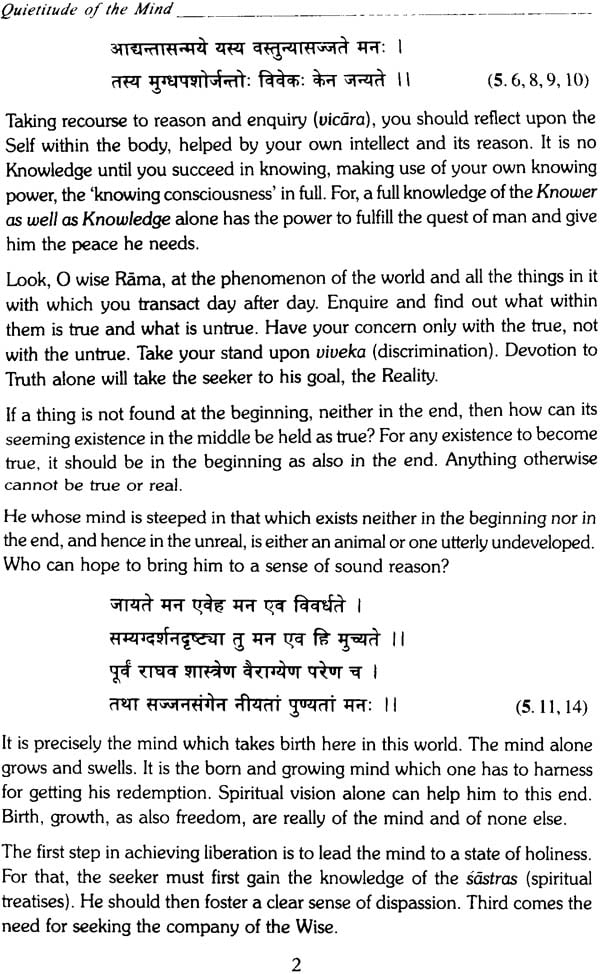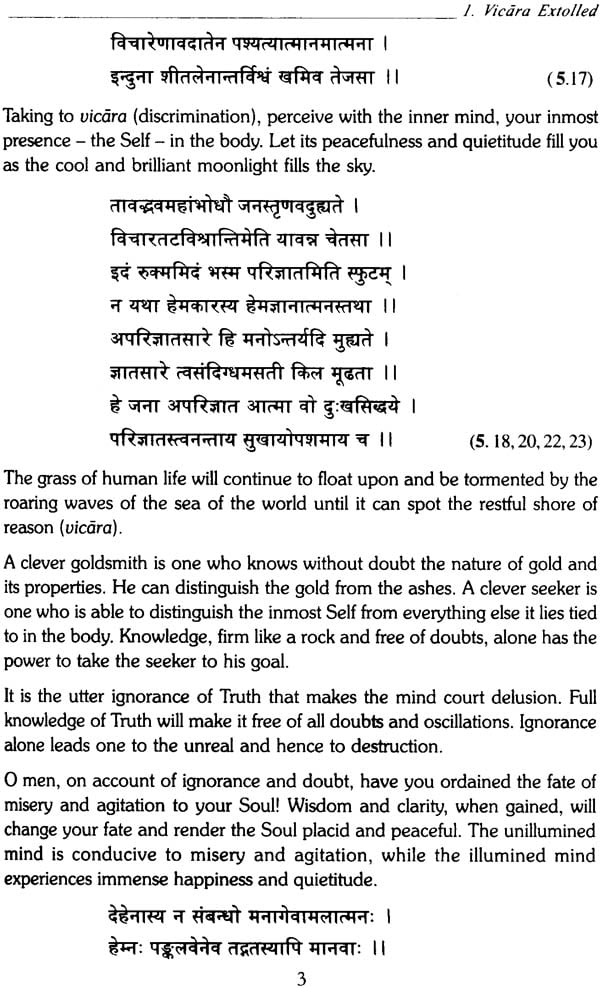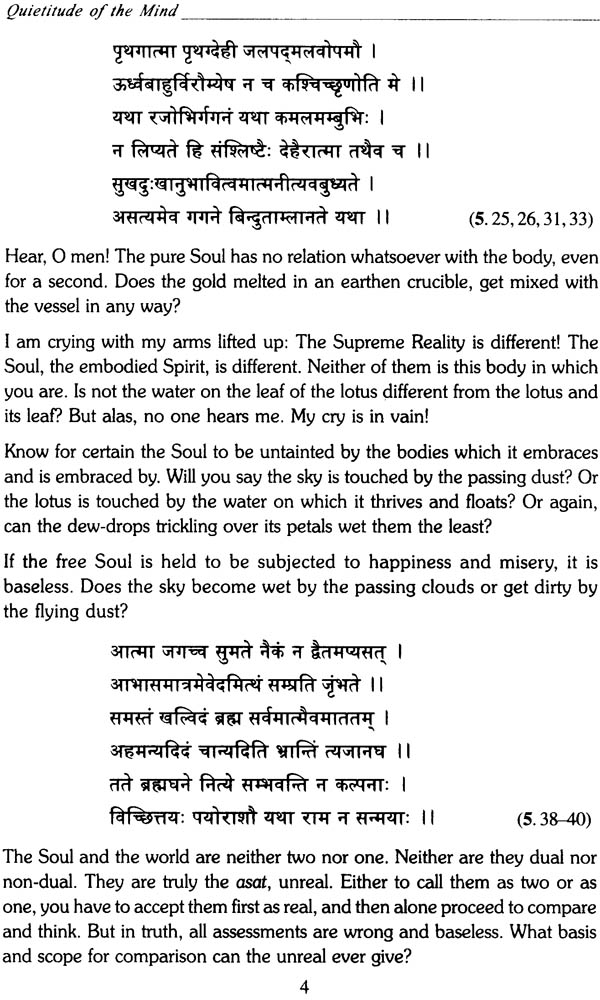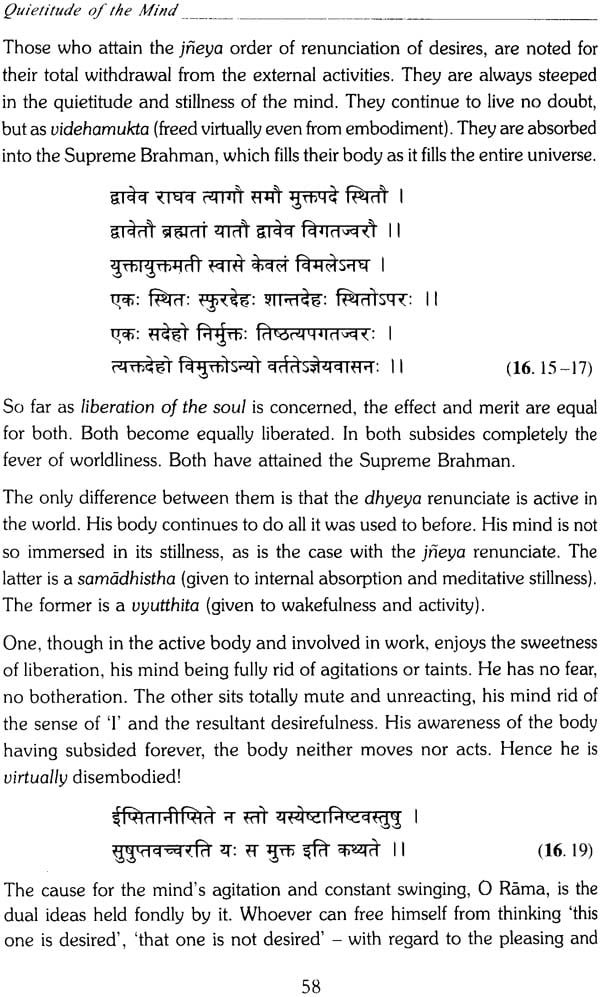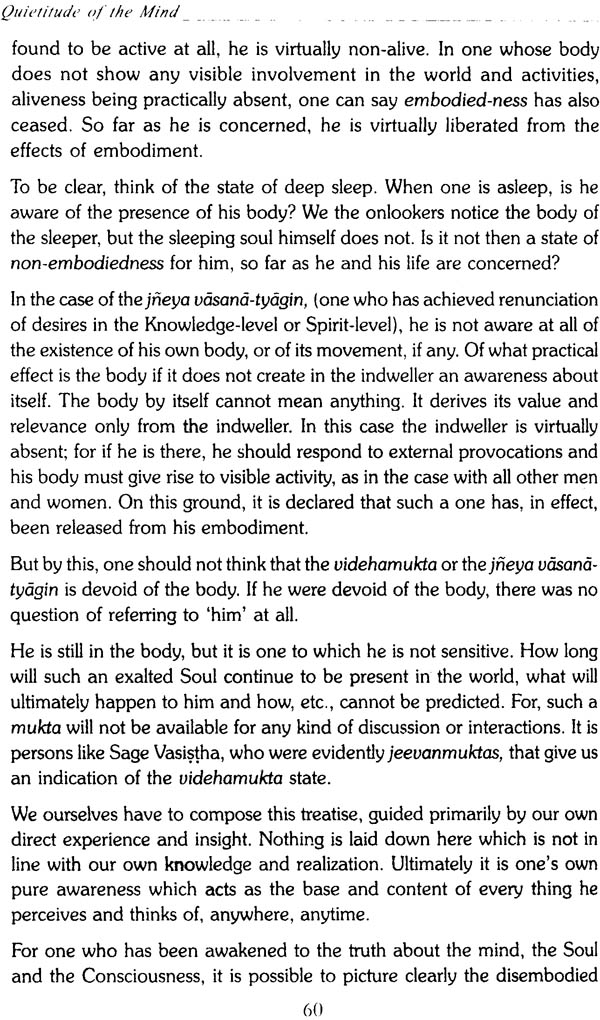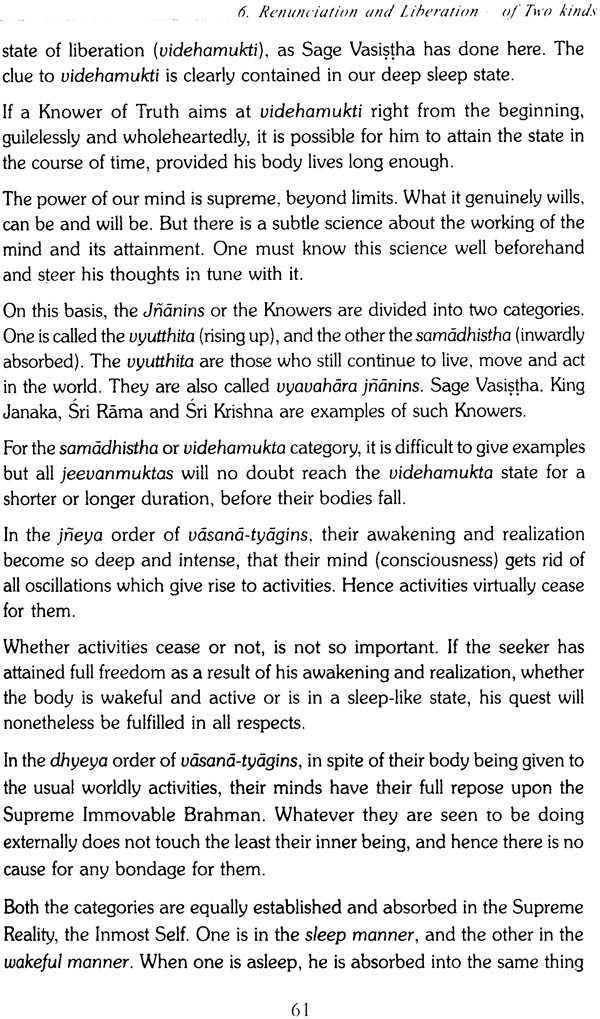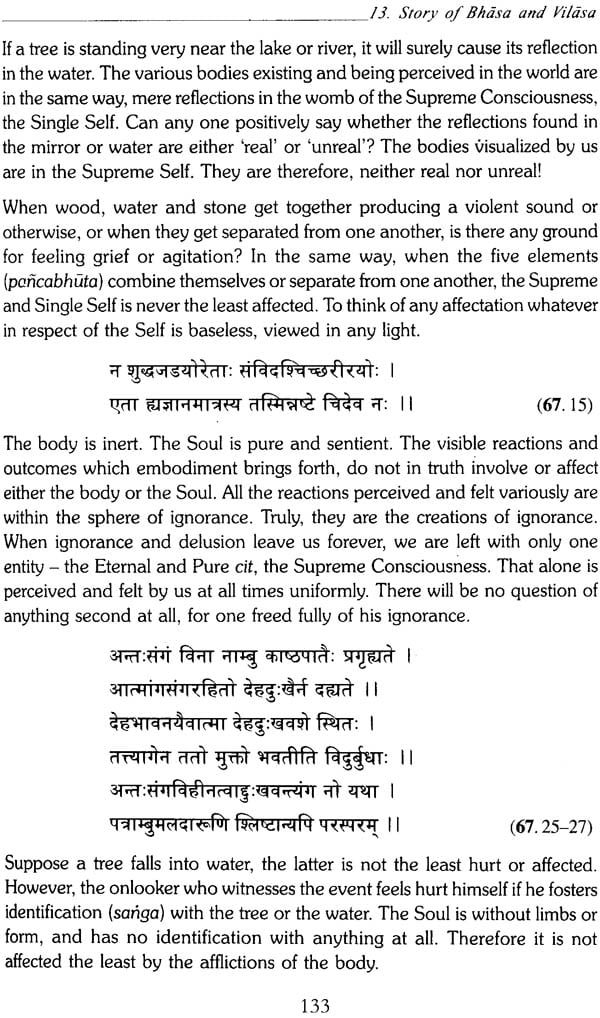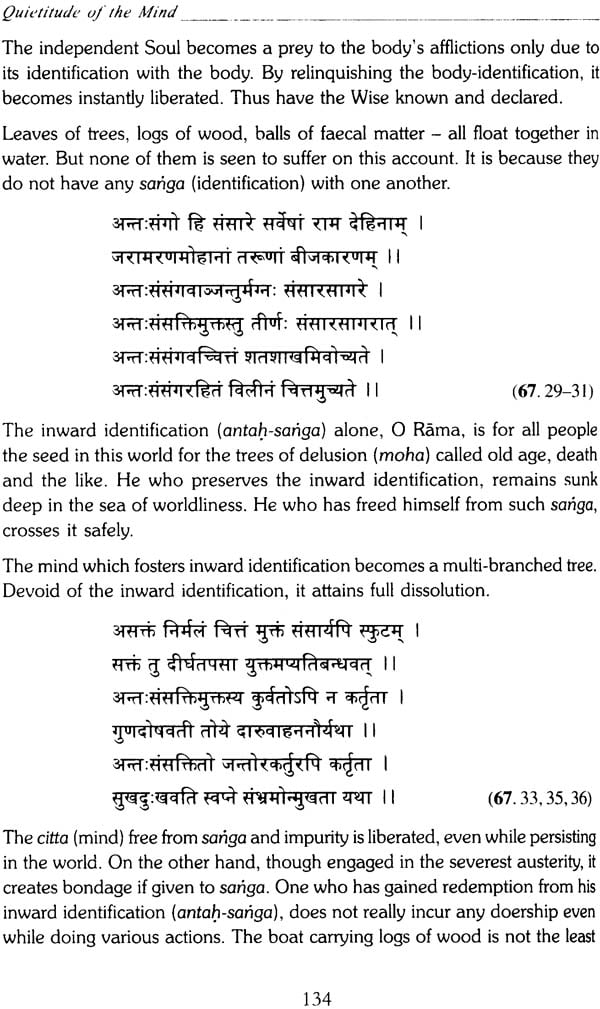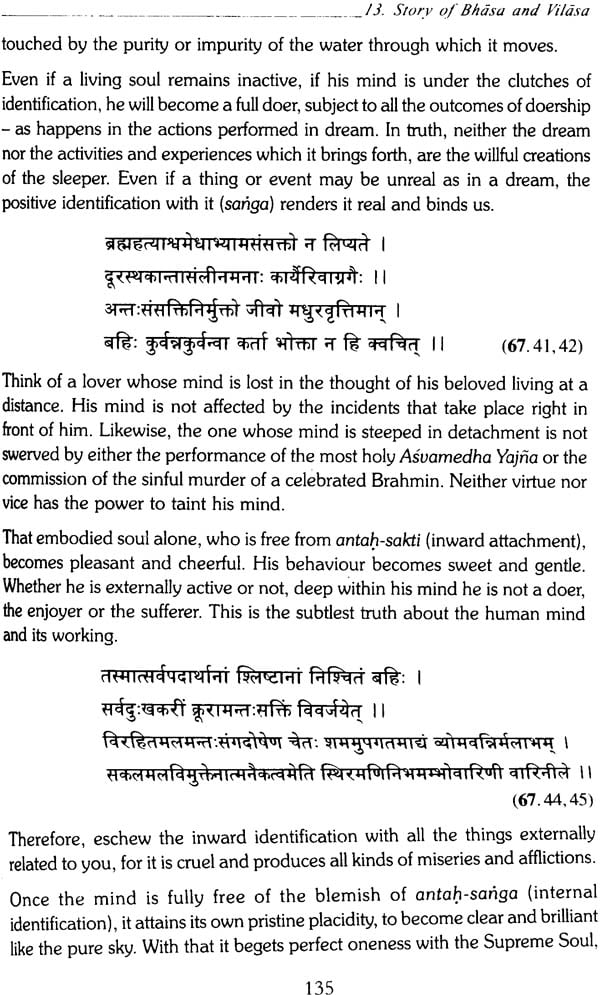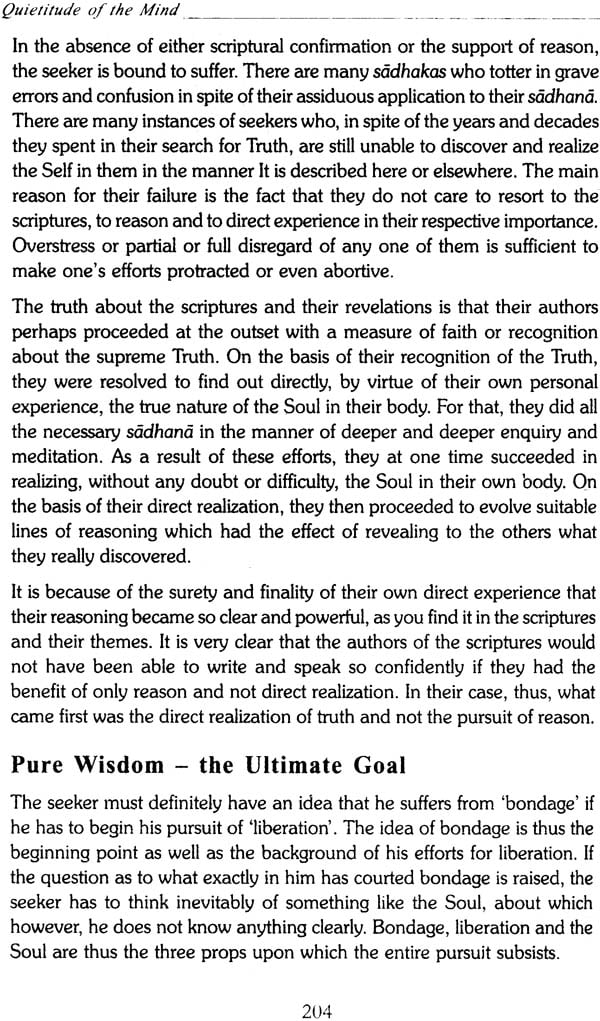
Quietitude of The Mind
Book Specification
| Item Code: | IHL191 |
| Author: | Swami Bhoomananda Tirtha |
| Publisher: | Narayanashrama Tapovanam, Kerala |
| Edition: | 2006 |
| Pages: | 238 |
| Cover: | Paperback |
| Other Details | 8.5 Inch X 5.5 Inch |
| Weight | 310 gm |
Book Description
The word Quietitude has been used in this book to convey the essential meaning of the Sanskrit word upasama as used in Yogavasishtha Ramayana. It denotes the transcendental serenity and poise of the mind gained by a process of enlightenment and sublimation.
The subject discussed throughout the book is condensation of the Upasama Prakarana of Yogavasishtha Ramayana. It is supplemented with in-depth discussions on important spiritual concepts.
The serenity implied by Quietitude does not in any way exclude the external activities and involvement. In fact the attainment of this enlightened subjective depth and fullness empowers one to pursue activities to a far greater magnitude while remaining anchored to the action less subject within what more? It has its unique sublimating influence on everything around be it a place a person or an event.
The original Yogavasistha records the dialogue between sage Vasistha and the young Sri Rama which lasted for 18 days beginning in the morning and terminating at dusk. Vairagya (dispassion) is the first subject dealt with by the author. It is followed by the section on mumuksu (the seeker of liberation) and his thoughts and attitude. Then comes the section on utpatti (evolution) of the universe which is followed by the one of sthiti (preservation). Upasama Prakarana or the section on Quietitude the subject matter of this book comes next and is followed by the last section on Nirvana or redemption and repose.
This book begins with the contents of the original text without giving any foregoing description or detail. This should not pose any problem to the readers for they would already be familiar with the spiritual and Vedantic thoughts either by reading or by listening to lectures. In fact in our publication this book comes only after Vedantic way of living and Brahma Vidya Abhyasa.
As the contents will reveal the subjects discussed are designed to take the seeker towards greater and greater understanding and realization. The stress is always on the practical aspect of sadhana although adequate theoretical knowledge and exposition have been provided. Repetitions are a characteristic of all spiritual and philosophical treatises of this land. The critical reader may not appreciate them but the assiduous sadhaka will value them immensely. We have retained repetitions only where essential. When the seeker reflects repeatedly upon the final truth the necessary clarity and Quietitude will emerge in his mind.
The whole of spiritual knowledge has only one aim. It is to make the mind of the thinking seeker absolutely free from constrictions and impurities thereby enabling him to be himself to be the self in him.
The pursuit of the self is unlike all other pursuits. It is not the pursuit of anything outside of us. On this ground it can be described as a pursuit of nothing and hence for the ardent seeker the true self pursuit must ultimately lead to the cessation of all pursuits. When the self pursuit thus ceases the so called self which had remained unsensed all the while comes to be rightly apprehended fully realized and constantly abided by, that makes a deep and unbroken sense of release acceptance and equipoise which is beyond description. It relieves man from all his bondage and given him the redemption and reward he so lovingly seeks in this fleeting world.
Yogavasistha impresses very strongly upon the seeker the supreme importance of the mind which is the seat of all experience and understanding. Everything inheres only in the mind. Both experience and knowledge subsist on the mind which is also their only cause. Even the thought of the self like any other thought is the mind’s own evolution. The mind is thus the first the intermediate and the last. At the same time the mind as we perceive and understand it now is not the supreme reality. The supreme reality is the supreme awareness or consciousness far greater in scope power and presence. It exists by itself without giving rise to anything else whatsoever. The mind is but a trickling offshoot a conjures up from of the supreme consciousness.
Although the mind is not what the supreme consciousness is yet the latter can be apprehended and realized only in and through the mind. Thus the mind acts as a beautiful and sure pointer to the supreme reality.
Grasp the mind learn to be in it as in an external abode and then realize the consciousness supreme which precedes the mind and which also follows everything in the end. This is the delicate spiral which Yogavasistha winds and holds for the seeker to pass through.
The discussions herewith lay great stress on the right pursuit of understanding as the real essence of spiritual sadhana. But this pursuit is not to be a more intellectual feat or indulgence. It should be a deep sublime and most effective process of purification and refinement for the seeker as Krishna says in the Bhagavad Geeta there is no purifier greater than knowledge it is directly experience able and immensely pleasant to practice therefore to regard this text as a sheer intellectual exercise and a source of joy is wrong. On the other hand it is a very lofty treatise on self knowledge and liberation. By the study and contemplation on it an earnest seeker is sure to gain purity right understanding realization in this very life.
Who is fit to read the book is a question which the original text itself poses in the beginning. It says in answer whoever has the idea that he is bound that he is in shackles and therefore has the need for freedom is qualified to read and make use of the text. He must be neither one who knows little nor one who knows all. The answer hardly needs further clarification.
In the past few decades while speaking on spiritual subjects in various cities towns and villages of our country I quoted a great deal from Yogavasistha. During the talks the Sanskrit verses I recited were primarily for my own joy. The explanation of their sublime contents which were delighting and enlightening brought forth a flood of enthusiasm in the listeners. Before long many of the more ardent seekers sought a brief account of this splendid work in the current form.
In the year 1973 when I happened to be on a tour of Malaysia and Singapore a devout listener succeeded in committing me to this laborious task through a timely gesture. The initial idea was to abridge the original text running into several hundred pages to a synopsis of about 200 pages avoiding reproduction of the original verses. However some of the students and seekers in our group desired that the original Sanskrit verses be included so that at least a part of the invaluable scripture of our ancient past would find the light of the present scientific age. That is how this book was begun and pursued to this extent.
On taking up the task I found that it would take years to cover the whole of the original text and this presented a fate of uncertainty in completing the mighty endeavor. Therefore in order to serve the immediate needs of the assiduous seekers I took up first the portion which has a direct bearing on their seeking. This gave birth to Quietitude of the mind which is an abridgement and commentary on the Upasama Prakarana. This book contains all the necessary truths and advice from which a true seeker can derive fulfillment for himself.
The devoted but joyful way in which I was writing this book often met with interruptions and it had to be called off on several occasion. My life and functions are earmarked primarily for needs of the seekers who often arrive at the Ashram for personal and direct communication. This means a sudden cessation of what is being written and reflected upon. The Ashram routines and the incidental spells of engagement sometimes lasting for hours and sometimes for days and months are another source of interruption. The first edition of this book was published in 1975 with the objective to present with love what was the best possible at that time. The writing took long hours of application on my part and also a good deal of assistance from mother Sulabha Devi of the Ashram.
In the second edition published in 1997 my disciples Swami Nirviseshananda Tirtha and Ma Gurupriya took the task of improving the content and presentation. The text was presented in 18 chapters each chapter containing a number of sections. My elucidation and analyses were highlighted in shaded boxes so that they stand distinct from the English meaning of the original verses. For precise rendering of the Sanskrit words and to facilitate their correct pronunciation transliteration marks were used. References were also provided for the Sanskrit verses as they appear in the Upasama Prakarana of the original Yogavasistha Mahramayana.
Whenever intricate points in the treatment and revelation of the more subtle aspects of spiritual life and enlightenment came up we had to put our minds and insights to be together. By a process of keen deliberation and reflection the truths had to be perceived and exposed. In a refined pursuit like this one should not commit himself to anything without the backing of his own direct realization of what he discusses and reveals. At the same time every possible effort had to be amide to complement the expositions with moderns standards of reason so that what is said can hold meaning and purpose even to the curious but tenacious readers and not only to the enlightened ones. On several occasions when reading the original Sanskrit verses and while rendering them in English my being was thrown into scintillating waves of joy and ecstasy. This coupled with the spontaneous love I have for both Sanskrit and English is the best reward I can think of for having attempted this task.
Floating and tossing like a small bubble on the rippling surface of the evanescent waves of this mysterious universe if during a short pause I can cause this little sparkle soothing perhaps to a handful only nature and providence stand to be credited and honored. What indeed is there in this world or anywhere else? It is only the unbridled play of the ceaseless tunes of nature and the alluring display of the sovereign gracious Almighty! The printing and release of the book has been possible only due to the cooperation physical, mental and otherwise of many dedicated souls. We at the Ashram are grateful to all who helped us in this humble endeavor.
May goodness and wisdom grace as many as possible on this earth and let the life of every one be led to its destined fulfillment.
| 1 | Vicara Extolled | 1-7 |
| 2 | Story of King Janaka and the song of Siddhas king Janaka in the forest Song of the Siddhas Siddha Geeta – The true worship | 9-15 |
| 3 | A sound reflection on life Janaka’s introspection Enlightened Assessment Tutoring the power of imagination | 17-28 |
| 4 | Janaka Liberated Glory of Reasoning True Spiritual life is within Magnificence of equal vision | 29-36 |
| 5 | Mind and its Effacement Mind, Thought and Soul The dead killing the living Grief but of no Avail Upasama Geeta – A song on falling of the mind | 37-54 |
| 6 | Renunciation and Liberation of Two kinds Renunciation of two kinds Liberation of Two kinds Jeevanmukti and videhamukti Desire – Binding and freeing | 55-63 |
| 7 | The Ways of a Jeevanmukta No Advaita while at work Awareness Alone Everywhere Make life a sport Liberation truly Redundant Do everything but Unaffectedly Outlook of the Noble minded Real Wisdom makes life a sport | 65-79 |
| 8 | Story of Punya and Pavana Relationships are Illusory The wise only witness Pavana Illumined Mind – the true Delighter | -81-88 |
| 9 | Realism of Vedantic Reasoning | 89-94 |
| 10 | Jnani and Jnana sadhana Who is superior the active or the inactive knower Jnana sadhana the deepest and most effective | 95-100 |
| 11 | Story of Suraghu Leave everything and the self is attained Suraghu Illumined | 101-109 |
| 12 | The Essence of true attainment Eka Samadhana Tattva-jnana counts not Samadhi No non-samadhi for the knower Deep rooted inwardness the essence of true attainment Self state truly Indescribable True attainment Never Slips | 111-125 |
| 13 | Story of Bhasa and Vilasa Self has no Relation no affectation Identification and deep sleep Susupti and Samadhi | 127-140 |
| 14 | Turiya and Beyond Asangata and Turiya Turiya the magic of wisdom fearlessness and fallacy of Death | 141-154 |
| 15 | Mind, the seat of the self Single Mind and its many names Mind substance source of all Existence The Dream Creation All names imply the same mind Gross things too are the mind All knowledge is rational Is objective finding any different Space an elusive concept Is it nothing and nowhere The Diametrical turn Mind substance the Supreme truth | 155-168 |
| 16 | Fate of objects in the hands of Reason More reflections on space The Inward Turn Again Imagination the first creator Mind Substance Independent and Beginning less Objects their ultimate value and status The summary Not Theology but science why think of space The Mind’s law Who is the Ideal Man | 169-178 |
| 17 | The Supreme Transcendence Transcending both life and death Is there death at all? Soul in the dead body as well Mind Its description Mind the source for self vision Self Transcends Everything Mind is the all but self is not the mind No existence besides consciousness Beyond bondage and liberation | 179-199 |
| 18 | Scriptures and Reason Versus Direct Realization Pure Wisdom – the ultimate goal The present and now real and valid Pure Wisdom Bestower of Supreme delight and fulfillment Limitation of Samadhi The Real Emphasis Pure Wisdom- the only inseparable gain | 201-210 |
| Index to Slokas | 211-218 | |
| Key to Pronunciation | 219-221 |

